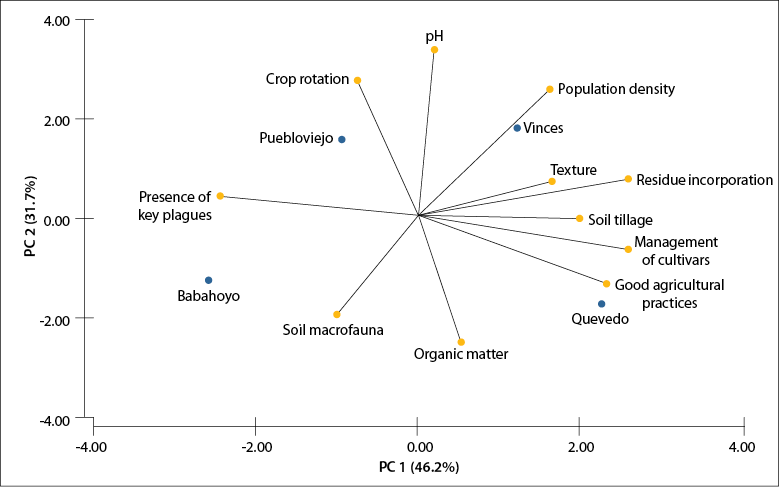Introduction
In Ecuador, soybean (Glycine Max L. - Fabaceae) was established in the 1970s as an alternative to reduce the use of foreign currency in the import of raw materials for the production of edible oils and fats, concentrates and balanced feeds for cattle, pigs and poultry. This legume is mainly exploited in the dry season (June-December) for crop rotation after corn or rice and to take advantage of the remaining soil moisture resulting from the rainy season (January-May) (Garcés-Fiallos et al., 2014).
The presence of the El Niño phenomenon (1983 and 1997) and the expansion of banana and African palm crops reduced the planting area during the previous decade to about 40,000 ha. This surface was limited to the south-central coast, specifically to the Guayas River basin, in the localities of Quevedo, Ventanas, Puebloviejo, Vinces, Antonio Sotomayor, Babahoyo and Montalvo in the provinces of Los Ríos, and also in Juján and Simón Bolívar in the province of Guayas. Currently, crops barely exceeds 20,000 ha at the national level, according to Sistema de Información Pública Agropecuaria (2018) [Agricultural Public Information System]. Further, Instituto Nacional de Estadística y Censos et al. (2002) [Instituto Nacional de Estadística y Censos] stated that 78 % of the soybean agricultural productive units (APU) correspond to small and medium producers, who plant between less than 1 ha and 20 ha in small APUs.
The III National Agricultural Census (Instituto Nacional de Estadística y Censos et al., 2002) defines APU as a land extension of 500 m² or more, totally or partially dedicated to agricultural production and considered as an economic unit, which develops its activity under the direction of its owner, contributes to food security and can generate a level of sustainability.
Currently, the need to make efforts towards sustainable agriculture is no longer questioned. This paradigm seeks to simultaneously meet objectives of productive, economic, socio-cultural and ecological dimensions (Sarandón, 2002), and this requires that the evaluation of sustainability be carried out through the dynamic systems approach and in a multidisciplinary way (Belcher et al., 2004; Kaufmann & Cleveland, 1995). For this, there are no universal parameters or criteria, and the appropriate methodological tools are still under development. One of the challenges that farmers, extension agents, and researchers face is knowing the health state of the agroecosystems. To assess their status, some specialists in sustainable agriculture have devised a series of sustainability indicators (Gómez et al., 1997).
When trying to measure sustainability, it is difficult to determine what should be evaluated. Given the significant inconvenience that time usually represents, a time scale of sustainability and unsustainability of approximately 25 years is established (Smyth & Dumanski, 1995). For sustainability analysis to be operational, it is convenient to characterize the behavior of an appropriate number of relevant indicators. These indicators must be adapted to the objectives and the scale of analysis, integrate variables, be sensitive to a wide range of conditions and changes over time, be easily measured, be reliable and be easy to understand (Sarandón, 2002).
Under this premise, the aim of the current research was to characterize the APUs that produce soybean in the province of Los Ríos using duly constructed indicators that account for the economic, socio-cultural, and ecological dimensions. With this, we hope to generate new information on the characterization of these units and on crop diversification, which will allow projecting changes in the productive matrix of the country.
Materials and methods
The study was carried out between July 2017 and January 2018 in the APUs that exploit soybeans as the main crop in the province of Los Ríos. The cantons of Vinces, Puebloviejo, Babahoyo, and Quevedo (figure 1) were chosen as representative places to carry out the research, due to their ideal weather conditions for the development of the crop. The geographical coordinates by locality are presented in table 1.
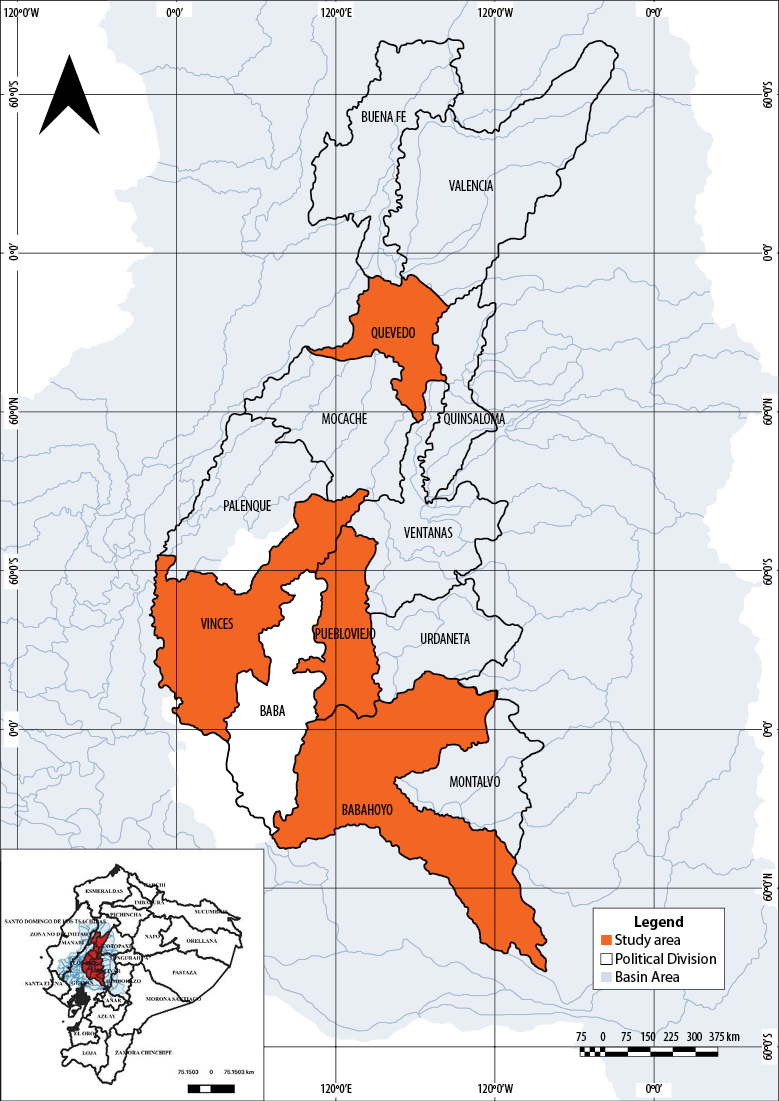
Source: Instituto Geográfico Militar [Military Geographic Institute] (projection WGS-84, zone 17 south [17S], EPSG 4326), Sistema de Información Nacional [National Information System] (provinces) and Secretaría Nacional del Agua [National Secretariat of Water] (basins), scale 1: 250,000
Figure 1 Guayas River basin (left) and cantons of Los Ríos and Guayas province where soybean is planted (right)
Table 1 Altitude and coordinates of the research sites

Source: Elaborated by the authors with GPS data
Surveys were applied to farmers in the four localities. Before carrying out these surveys, workshops were held to explain the fundamentals of the survey sheet and to validate the matrices with the participation of the producers, by generating feedback for the research instrument to be used, according to the proposal of Bolívar (2011).
The population was established according to the information consolidated by Monteros (2016) on the total number of producers (2,711) in the province of Los Ríos between June and November 2016. The sample was calculated using the following formula for a finite sample.
Where N: 2,711 (total population);
Through a structured survey based on socio-cultural, economic, and environmental indicators (Sarandón, 2002), field data was collected. The information obtained was then systematized in frequency tables using Microsoft Excel, version 10. Using the SPSS software version 20, a principal component analysis was carried out for each dimension to explain the higher variability between the indicators based on their similarity and, in this way, achieve a better interpretation during the characterization process of the APUs. The main variables focused on economic, socio-cultural, and ecological or environmental aspects. The components were defined according to the priority and impact levels, for which the participation of a group of experts and leader peasants were included.
In the economic component, priority was given to productivity, production costs, sales price, benefit-cost ratio, monthly net income, APU area, seed quality, input dependency, and the planting season. For the socio-cultural aspect, data on the type of housing, educational level, access to health, basic services, age of the producer, level of producer satisfaction, level of knowledge about cultivation, and level of integration, were considered. In the environmental component, the incorporation of residues or waste, crop rotation, soil macrofauna, organic matter, cultivar management, pH level, soil tillage, and population density were considered.
Aspects related to soil health were also analyzed. For soil macrofauna, the Tropical Soil Biology and Fertility Programme (TSBF) method developed by Anderson and Ingram (1993) was used. In this analysis, a sampling unit of 25×25×20 cm in length, width, and depth, respectively, was used. Samples were randomly taken at a depth of 20 cm at four points in zigzag within the plots and a subsample every 15 steps from each point after cleaning the soil surface to examine the physicochemical aspects of the soil. Then, all the subsamples were homogeneously mixed, and a soil sample of 1 kg was collected, labeled and sent to the laboratory to carry out different analyses, including texture, pH, organic matter, total nitrogen, available phosphorus, available potassium and the following cationic ratios: Ca/Mg, Ca/K, Ca+Mg/K, and Mg/K. The methodologies used were those established by Red de Laboratorios de Suelos del Ecuador (Relase) [Network of Soil Laboratories of Ecuador].
Results
Economic characteristics
Table 2 shows the distribution of the data grouped into classes and with frequencies of each class. The relative frequency indicates that 45 % of the APUs have a good average yield of 2.7 t/ha (potential 3.0 t/ha), and 39 % have an average of 2.3 t/ha. Fifty-five percent of the APUs with soybean have an average area of 5 ha. Production costs at 61 % indicate a value higher than $ 600, and the general average is $ 432, a low value when compared to corn, which is close to $ 1,329.22. The relative frequency establishes for the sale price that 54 % sell soybeans at $ 260/t and 46 % at $ 250/t. Intermediaries have 50 %, and direct sales to the consumer represent the remaining 50 %.
Table 2 Frequency analysis of economic characteristics
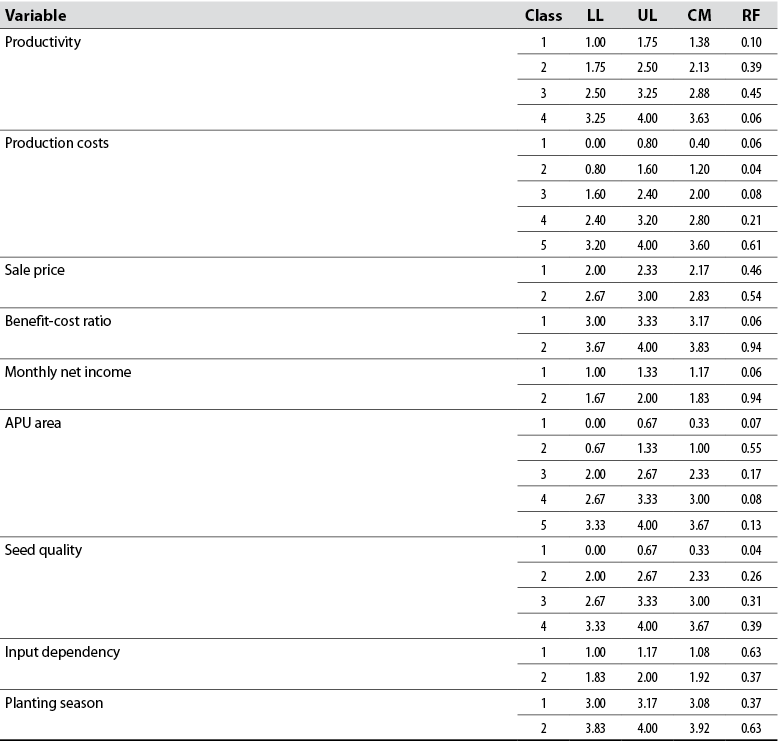
LL: lower limit, UL: upper limit, CM: class mark, RF: relative frequency
Source: Elaborated by the authors
The benefit/cost ratio of 94 % (net benefits between investment costs) allows the investment to be recovered. A similar percentage was found for families with an average income of $ 350. In general, most farmers use good quality soybean germplasm; 39 % of the producers claim to receive certified seeds through the government or unions; 31 % mention that the seed is not certified, but they know their origin, and 4 % do not know the origin of the seed. Something interesting is that 26 % of the producers stated that the germplasm used is their own.
About 37 % and 63% of the producers, which correspond to medium and high levels, respectively, depend on external inputs (some external to the APUs). Specific inputs such as fertilizers, herbicides, and insecticides are negatively related to the environment. However, when comparing soybeans with rotational crops used for corn and rice, the use of these inputs is lower. Regarding the planting season, soybeans are planted during the dry season in May (63 %) and June (37 %) to take advantage of the remaining soil moisture deposited during the rainy season. This legume is used in rotation systems with crops such as rice and corn, which are cultivated during the rainy season.
Socio-cultural characteristics
Table 3 shows that 68 % of the farmers live in concrete houses with good conditions, and 30 % live in mixed houses (wood and concrete). About 4 % of the farmers have a university education level, 30 % a secondary level, 62 % a primary level, 1 % have not yet finished primary school, and 3 % have no education (illiteracy level).
Table 3 Frequency analysis of sociocultural characteristics
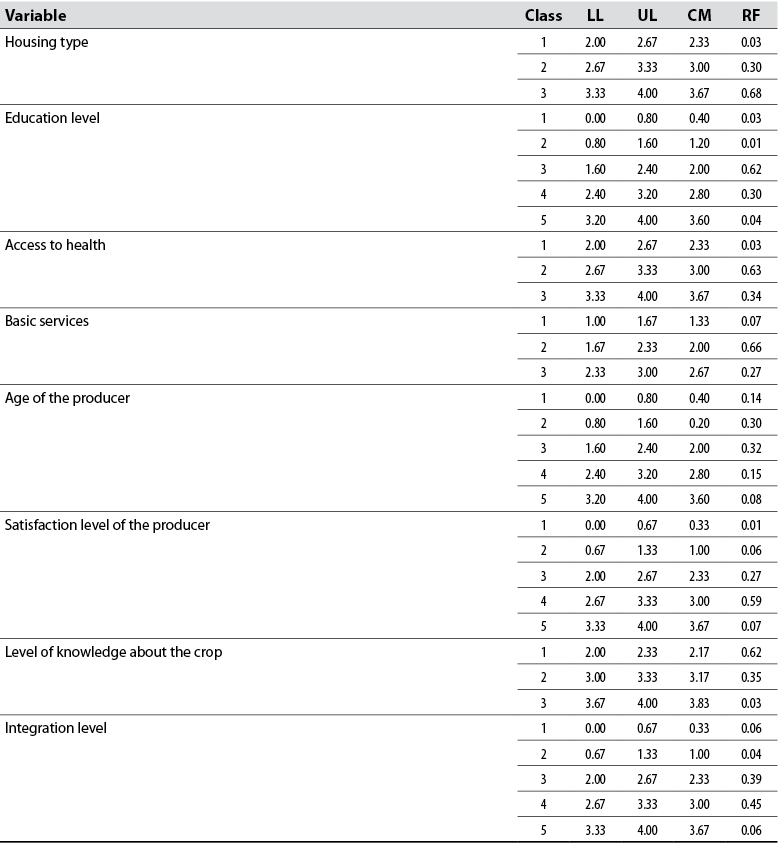
LL: lower limit, UL: upper limit, CM: class mark, RF: relative frequency
Source: Elaborated by the authors
In relation to access to health and health coverage, we found that 63 % of the respondents have a health center with adequate infrastructure and temporary doctors, and 34 % have an equipped health center with permanent personnel. Regarding access to basic services, 66 % have electricity and water collected through wells, and 27 % have potable or drinking water and electricity, perhaps due to its proximity to populated centers. It seems that there is pressure on the demand for water to meet the needs of the population and the unequal distribution of water suitable for human consumption. Besides, the extensive banana and oil palm plantations demand a large quantity of the water resource, which generates unsustainability of the system.
The average age of soybean producers is 54 years. It appears that young people are not properly engaged in agricultural activities, and in many cases, they sell the land to large banana and oil palm companies.
On the other hand, 59% of the producers are satisfied with the agricultural activity; although they consider that agriculture is not the best business, they mention an emotional bond with the land. The knowledge of respondents on crop management is considered good by 62 % and fair by 35 %. Training on new technologies is considered necessary to enhance the knowledge acquired by the producer. Likewise, 45 % of the producers claim to belong to an organization, especially of an agricultural nature. One of the advantages that associated farmers have is access to financial credit and State aid programs.
Environmental characteristics
Table 4 indicates that 42 % of the producers incorporate stubble from the previous crop to the soil, 52 % use rotation within their cultivation system, and 48 % rotate soybean cropping every two years. This is common among soybean producers, as this legume is planted after rice or corn as a rotation crop.
Table 4 Frequency analysis of environmental characteristics
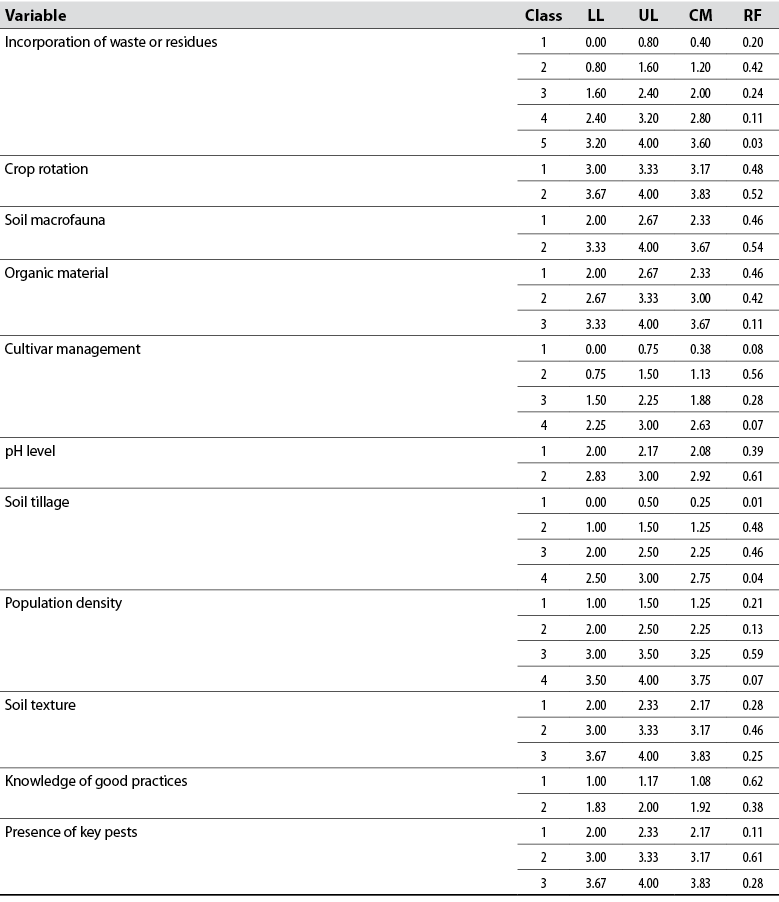
LL: lower limit, UL: upper limit, CM: class mark, RF: relative frequency
Source: Elaborated by the authors
The presence of soil macrofauna where soybean is cultivated is at a good quality level according to 54 % of those producers interviewed, while 46 % report that it is of low quality. Regarding the use of cultivars, at least two and three varieties are used by 56 % and 28 % of the farmers, respectively. The soil pH is close to neutrality with a value of 5.6, which provides good conditions for soybean cultivation.
Soil preparation is the most common practice among farmers; about 48 % and 46 % perform two and three passes with a heavy harrow, respectively. Most farmers (59 %) use an average population density of 200,000 plants per hectare, an ideal figure for maintaining soil cover. The soils were classified as loam, silt loam, and clay loam, ideal for soybean production. Good agricultural practices are found to be between low and medium, with percentages of 62 % and 38 %, respectively. Among the biotic factors that affect soybean production the most, 28 % and 61 % of the producers mentioned that the crop is affected by two and three pests, respectively. The main pests are the insects Cerotoma facialis Erichson (Coleoptera: Chrysomelidae) and Omiodes indicata Fabricius (Lepidoptera: Crambidae), and the fungus Phakopsora pachyrhizi Syd. & P. Syd. (Fungi: Uredinales: Phakopsoraceae).
As seen in figure 2, the first principal component (PC1) separates the Vinces locality from the others; therefore, the highest variability between the main economic characteristics applies to this variable. The dependence on external inputs, the benefit-cost ratio, and production costs are more associated with the locality of Vinces. The planting season is more associated with the locality of Babahoyo. The monthly net income and the quality of the seed are related to the locality of Puebloviejo. Finally, the productivity and APU area are associated with the locality of Quevedo. These two axes explain 88.3% of the total variability of the observations. The orthogonality of the principal components ensures that the second component (PC2) provides new information on variability; that is, it explains the variability between economic characteristics and localities that PC1 did not explain.
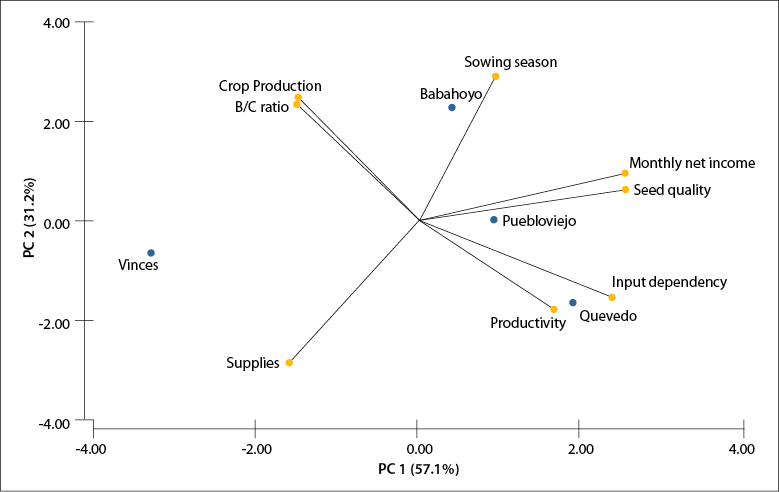
Source: Elaborated by the authors
Figure 2 Principal component analysis for economic characteristics
As figure 3 shows, the first principal component (PC1) separates the localities of Vinces and Puebloviejo from the others, so the highest variability between the main socio-cultural characteristics is applied to these variables. The level of knowledge about crop management and the level of producer satisfaction are associated with the localities of Vinces and Puebloviejo. The locality of Quevedo is mostly related to basic services, educational level, and integration level; meanwhile, the locality of Babahoyo is associated with the type of housing and access to health and sanitary coverage. With these two axes, 82.1 % of the total variability of the observations is explained. The orthogonality of the main components ensures that PC2 provides new information on variability compared to what PC1 provided.
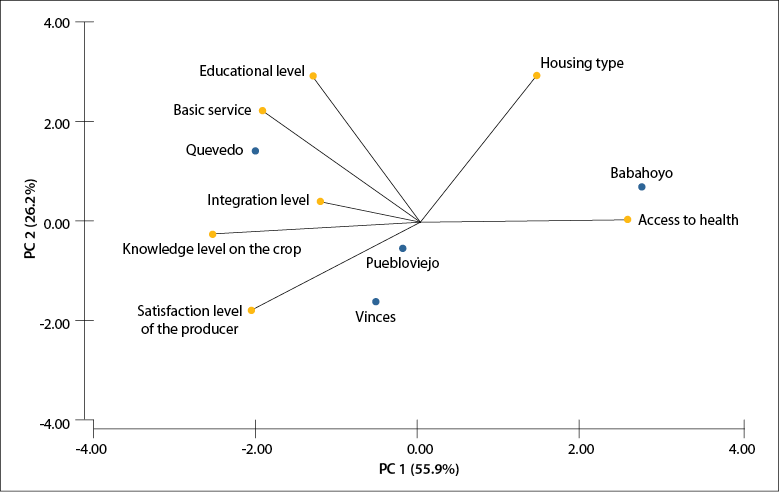
Source: Elaborated by the authors
Figure 3 Principal component analysis for socio-cultural characteristics
Figure 4 shows that PC1 separates the Babahoyo locality from the rest so that the highest variabilities between the main environmental characteristics are applied with these variables.
The soil macrofauna is associated with the Babahoyo locality. The presence of key pests and crop rotation are related to the locality of Puebloviejo. Soil pH, population density, soil texture, and incorporation of waste or residues are associated with the locality of Vinces. On the other hand, the Quevedo locality is related to soil tillage, cultivar diversification, knowledge of good agronomic practices, and soil organic matter. With these two axes, 77.9 % of the total variability of the observations is explained. The orthogonality of the principal components ensures that PC2 provides new information on variability compared to what PC1 provided.
Discussion
The average yield of 2.7 t/ha observed in the analyzed APUs is higher than the national average of 2 t/ha reported by Monteros (2016). This behavior may be associated with good soil conditions in the sector. Production costs had a general average of $ 432, probably due to the subsidy on an input package offered by Programa Plan Semilla de Alto Rendimiento [High Yield Seed Plan program], implemented since the summer of 2015 (Moreno & Salvador, 2015).
The sale price of soybeans is between $ 250-260/t, i.e., lower than the price of $ 300/t set in the country (Ministerio de Agricultura y Ganadería, 2012). The average of the segment that sells at a lower value may be associated with the distance from the main legume collection centers. Considering that the coefficient of the benefit/cost ratio is 1.5, there is evidence of a return on investment plus a profit margin, in agreement with Méndez (2010). This has probably prevented the crop from disappearing.
Each farming family receives a monthly average income of $ 350. This value is less than the monthly income of $ 375 for a typical Ecuadorian family comprised of four members estimated by Ministerio de Trabajo (2017) [Ministry of Labor]. However, the financial income of a soybean producer varies as he/she benefits from other crops such as cocoa, bananas, rice, and corn.
Soybean cultivation has a relatively low cost and requires little monetary investment, compared to corn hybrids, which generate a high demand for off-farm and highly dependent inputs. On the other hand, the simplicity of its management makes this crop attractive since there is no need for sophisticated knowledge or tools.
Producers establish soybean cultivation during the dry season, between May and June, to take advantage of the remaining soil moisture produced during rainfall. The use of the remaining water is essential to guarantee good grain production and reduce financial costs. Without a doubt, soybean is used as an alternative to planting traditional crops such as rice and yellow corn, and currently constitutes the main rotation crop (Garcés-Fiallos et al., 2014; Monteros, 2016).
The type of housing that producers have is in good condition. Kothari and Chaudhry (2012) describe housing as a fundamental support for the sustainability of human development, so this variable meets the budgets for sustainability. On the other hand, the educational level can be described as adequate. In this regard, Organización de las Naciones Unidas para la Educación, la Ciencia y la Cultura (2014) [United Nations Educational, Scientific and Cultural Organization] relates education to the poverty factor. In this sense, poverty is a hereditary condition if it is not possible to improve the education of children. The current study revealed that there is a low illiteracy in the sector (1%). Health is part of international and state policies as an indispensable requirement for sustainability indicators, which, in turn, determines the type of public policy (Tejada de Rivero, 2013). In Ecuador, this variable is insured in the rural area through Sistema de Seguro Social Campesino [Rural Social Security System], which provides health coverage to the member and his children.
The drinking water supply network is deficient in most localities, and this is likely to be one of the causes of health problems. This agrees with the findings of Molina (2002), who indicates that the provision of basic services is inefficient and economically unsustainable in countries like Ecuador.
The average age of farmers is 54 years, which may be a problem in the future since the children are not empowered to carry out farming and choose to sell the land to transnational industries. The increase in land concentration under pressure conditions on smallholders is generating the emergence of a new social stratum in the countryside called "the landless," people who have lost their properties and sell their labor force for a salary (Sistema de Investigación sobre la Problemática Agropecuaria en el Ecuador, 2011).
Knowledge on crop management is considered good, despite the lack of existing training in the sector that is evidenced by specific questions on crop management. However, a participatory development process is required to achieve the empowerment of new cultivation technologies, such as the management of a direct sowing system that disturbs the soil to a lesser extent (Benzing, 2001).
Although soybean planting areas are small, this crop is established under rotation. In fact, legumes are a rotation alternative to monoculture. In other countries, the use of sequential rotation with grasses has been shown to increase grain yield by 10 % compared to monoculture (Bacigaluppo et al., 2009). The analysis carried out to the soil shows that it has good organic matter content conditions (3.4 %). This characteristic is ideal for conserving the diversity of organisms that contribute to soil health (Romig et al., 1996); nonetheless, soybeans probably have an influence on the improvement of soil conditions.
Diversification of cultivars is a good indication of production sustainability. This is of great importance as long as a variety of production policies is maintained in situ, since dependency is a negative factor (Pengue, 2001). The expansion of soybean at the expense of the introduction of materials obtained abroad could increase dependency, putting the sustainability of the system at risk, and even generate health problems.
The soil texture is between loam, silt loam, and clay loam, i.e., ideal conditions for soybean production, according to Guamán et al. (1996). Good agricultural practices are classified between low and medium, which may be associated with the lack of knowledge of farmers about the adverse effects on the environment.
The population density of 200,000 plants per hectare used by producers and considered adequate to maintain soil cover is higher compared to what Monteros (2016) reported (160,000 plants per hectare). This is probably due to the planting method (broadcast distribution), which does not guarantee good seed distribution.
According to the perception of farmers, the external factors that most affected soybean production in 2016 were pests and diseases. The producers interviewed stated that the crop is affected by C. facialis, O. indicata, and P. pachyrhizi. Of all the pests, Asian rust is the main biotic factor for legumes. Besides, the disease can negatively affect the number and yield of grains per pod (Garcés-Fiallos et al., 2014; Painii-Montero et al., 2018).
The information generated from the economic, socio-cultural, and ecological indicators analyzed in each of the soybean APUs can be used to improve this small agricultural sector that has been neglected in recent years.
Conclusions
The production costs of soybean cultivation are relatively low and represent an advantage over other crops in the area. Soybean producers show a low level of illiteracy, good access to health coverage (peasant health insurance system), medium age, good knowledge on crop management, and adequate organization.
Soybean cultivation is presented as a good alternative for the diversification of the agricultural production of Ecuador due to its low production cost, use of the remaining soil moisture, and as a rotation crop option. For these reasons, it can be the basis for projecting changes in the productive matrix of the country.











 text in
text in 



